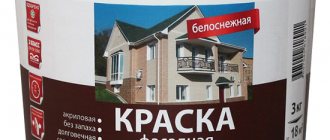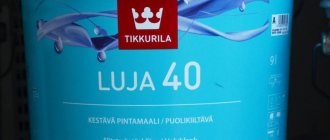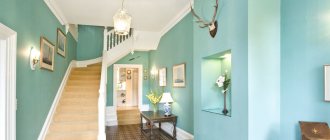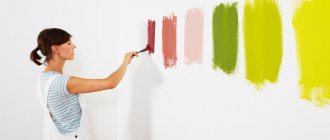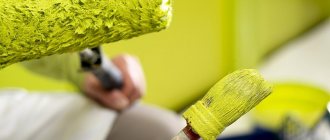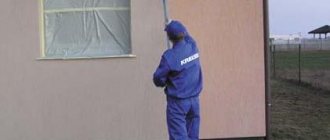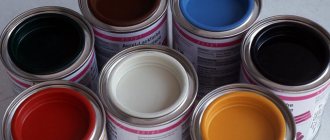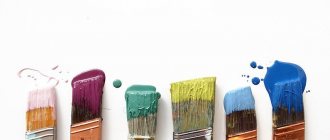Water-based facade paint VD-AK-1180 can be used both for exterior work and for painting concrete, brick and plastered interior walls, including rooms with high humidity. The paint dries quickly and has no unpleasant odor. After the paint dries, a matte layer is formed that is resistant to abrasion, washing and other physical influences.
The color and quality of the protective film are preserved under conditions of exposure to precipitation, sunlight, temperature changes and other weather conditions. We produce and sell water-based paint for facade and interior work VD-AK-1180 at a wholesale price in St. Petersburg.
Purpose of water-based paint VD-AK-1180
VD-AK-1180 paint is intended for painting the facades of buildings and structures, but can also be used indoors, including those with high humidity.
The material can be applied to plastered, brick, concrete, wood and other porous surfaces.
After the paint dries, a matte surface that is resistant to washing, abrasion and other mechanical influences is created.
The paint retains its properties when exposed to ultraviolet radiation, precipitation, negative temperatures and other environmental influences.
Description of material
Acrylic coating VD-AK-1180 is a white, oily substance without a pungent odor. It does not contain heavy chemical elements. Water is used as a solvent. And with the help of tinting you can change the color and create the desired shades.
Thanks to the acrylic base, the paint has unique properties. It has good adhesion to various surfaces with:
- tree;
- concrete;
- gypsum board;
- brick.
The coating is used both for decorative work and for creating additional protection for the structure. Decorative painting can be in different colors if you use pigments. Decorative qualities are preserved for a long time even under unfavorable conditions. Acrylic VD-AK-1180 is used as a texture base for interior and exterior design.
After drying, a film is formed that hides small cracks and irregularities, but the coating remains “breathable”.
- Non-toxic.
- Wear-resistant.
- Does not change under the influence of sun, rain, frost.
- Prevents the formation of fungus and the development of bacteria.
- Fireproof.
Technical characteristics of paint VD-AK-1180
Paint film color: main - white and other colors, production of any color and shade at the request of the customer.
Appearance: smooth, uniform matte surface.
Mass fraction of non-volatile substances, %, not less than – 55.
The covering power of the dried film is 160-180 g/m2.
Paint pH is 6.5-9.5.
Degree of grinding, microns, no more than 80.
Drying time to degree 3 at a temperature of 20° C, no more than 1 hour. Resistance of the film to static exposure to water at a temperature of 20° C, no less than 24 hours.
Washability of the paint film, no more than 2 g/m2.
GOST R 52020-2003
Paint composition: acrylic paint, which is a suspension of pigments and fillers in an aqueous copolymer acrylic emulsion with the addition of various auxiliary substances.
Application of water-based paint VD-AK-1180: intended for high-quality painting of building facades, can also be used for painting interior spaces. Used to form high-strength coatings. Used for work on concrete, plaster, wood, cement, plasterboard, brick, putty and other porous surfaces.
Properties of water-based paint VD-AK-1180 : creates a coating resistant to UV rays. It has increased adhesion, water resistance and hiding power. The paint coating withstands temperature fluctuations well and smoothes out roughness of the surface being painted. The paint does not contain solvents or harmful impurities. Advantageous when painting large areas.
Color: white, shade is not standardized. Tinting with aqueous pigment pastes in any color is allowed as agreed with the Consumer.
Application of water-based paint VD-AK-1180 : the surface must be clean, dry, durable. To increase the service life of the coating, it is recommended to pre-treat fragile and highly absorbent substrates with a water-based primer. Stir the paint before use. If necessary, to reduce viscosity, dilute with water no more than 5% of the paint weight. For application use a brush, roller or spray gun. It is recommended to apply paint at a temperature not lower than +7°C.
Consumption of acrylic paint VD-AK-1180 for a single-layer coating: 160 - 200 g/m2.
Withstands freezing down to -40°C for no more than one month or five freeze-thaw cycles. In case of freezing, defrost the paint for 24 hours at an ambient temperature of at least 15°C and mix thoroughly until a homogeneous mass is obtained.
Guaranteed shelf life: 12 months from the date of manufacture.
Technical specifications
| Indicator name | Meaning |
| Color | Must be within the permissible deviations established by the Card Index color samples (standards) or approved control color samples |
| Appearance of the coating | After drying, the VDLKM should form a homogeneous surface, without craters, pores and wrinkles |
| Mass fraction of non-volatile substances, %, not less | 50 (33) |
| pH | 6,5 — 9,5 |
| Drying time to degree 3 at temperature (20 ± 2) C, h, no more | 1 |
| Conditional viscosity at a temperature of (20.0 ± 0.5) °C according to a VZ-246 viscometer with a nozzle diameter of 4 mm, s, not less | 14 |
| Degree of grinding, microns, no more | 70 |
| Film washability, g/m2, no more | 3,5 |
| Resistance to static effects of water at a temperature of (20 ± 2) °C, h, not less | 12 |
Surface preparation.
Attention! The quality of the coating depends 50% on the preparation of the base, 20% on the correct application and 30% on the quality of the paint.
There are 3 main ways to clean the surface before painting:
Various removers can be used to remove old paintwork. On the old coating with enamels PF-115 and MA-15, either a special primer or concrete contact is applied, or it is matted and cleaned with abrasive sandpaper. The surface to be painted must be cleaned of dust, grease and other contaminants. Usually washed with water, the surface must be dried.
The concrete surface is treated with VD-AK primer, an acrylic primer, deep penetration, having a milky translucent tint and liquid consistency. For old crumbling surfaces, a more highly filled soil is used - concrete contact.
Preparation and application of enamel.
The quality of the coating is affected by:
- Ambient temperature.
- Temperature VD-AK.
- Atmospheric conditions.
Attention! Cannot be applied:
- On an ice-covered surface.
- When it rains or snows.
- Painting at temperatures below 5°C is not recommended, since the water present in the material will simply turn the VD-AK into stone.
Most manufacturers add special additives to VD-AK, which gives it 5 freeze-thaw cycles. In winter, many manufacturers who do not have warm warehouses actually sell “stones”. Nothing wrong with that! The paint just needs to be kept for 24 hours at room temperature away from heating appliances! And then mix thoroughly - and, please, work!
If necessary, VD-AK can be diluted to working viscosity with water, but not more than 5-10 percent. VD-AK is applied by spraying or by brush or roller onto a previously prepared surface, cleaned and primed with a deep penetration primer or concrete contact. Usually it is enough to apply 2-3 layers of paint, pausing for 1 hour between layers.
The drying time for each layer of VD-AK at a temperature of (20 ± 2) °C is 1 hour. The drying time is reduced if the temperature is above 25 degrees. The consumption of VD-AK Paint is usually 150-250 g/m2, depending on the type of surface. For example, the consumption on a porous concrete surface will be significantly higher than on a pre-primed surface.
If you use colored paint that has been tinted to a specific color, there are sometimes complaints that the painted surface is not uniform in color. This is due to the porosity of the surface! It must first be treated with primer, or you can use the same paint, diluted 40-50% with water, for the first layer. Next, apply 2-3 layers of base paint. There is also a rule. One batch of paint should cover the wall from corner to corner. Since different batches of paint may vary slightly in shade.
SAFETY REQUIREMENTS
2.1. Water-dispersion paints are fire and explosion proof.
2.2. During the production, testing and use of paints, fire safety and industrial sanitation requirements in accordance with GOST 12.3.005 must be observed.
2.3. All work with paint must be carried out in rooms equipped with supply and exhaust ventilation, ensuring the air condition of the working area in accordance with GOST 12.1.005.
2.4. The maximum permissible concentrations and hazard class of vapors of monomers and paint components are given in table. 2.
table 2
| Component name | Maximum permissible concentration, mg/m2 | Hazard Class | ||
| in the air of the working area of the production premises | in the water of reservoirs | in the atmosphere | ||
| Polyvinyl acetate dispersion: | ||||
| on vinyl acetate | 10 | 0,2 | 0,15 | 3 |
| by acetaldehyde | 5 | 0,2 | 0,01 | 3 |
| on dibutyl phthalate | 0,5 | 0,2 | — | 2 |
| Latex butadiene nitrile: | ||||
| for acrylonitrile | 0,5 | 2,0 | 0,03 | 2 |
| Styrene-butadiene latex: | ||||
| for styrene | 30/10 | 0,1 | 0,003 | 3 |
| Emulsion MBM-5s: | ||||
| by methyl methacrylate | 10 | 0,01 | 0,1 | 3 |
| for butalacrylate | 10 | 0,01 | — | 3 |
| for methacrylic acid | 10 | 1,0 | — | 3 |
| Ethylene glycol | 5 | 1,0 | — | 3 |
| Thiuram: (tetramethylthiuram disulfide) | 0,5 | 1,0 | 0,006 | 2 |
| Aerosil | 1,0 | — | — | 3 |
| Pentachlorophenolate | 0,1 | 5,0 | 0,001 | 1 |
| White Spirit | 300 | — | — | 4 |
| Titanium dioxide | 10 | — | — | 4 |
2.5. The harmful substances that make up the paint have a toxic effect on the hematopoietic organs, nervous system, skin, mucous membranes of the eyes and respiratory tract. The dried coating has no harmful effects on the human body.
2.4, 2.5. (Changed edition, Amendment No. 1).
2.6. Persons associated with the manufacture, testing and use of paints must be provided with special clothing and personal protective equipment in accordance with GOST 12.4.011 and GOST 12.4.103.
2.7. Monitoring compliance with maximum permissible emissions (MPE) into the atmosphere, approved in accordance with the established procedure, must be carried out in accordance with GOST 17.2.3.02.
Properties of water-dispersed acrylic paints
Acrylic water-dispersion paints contain a number of components that are the same for different types of material. These are solvents, pigments, and binding ingredients. The latter include acrylic resins. Paints of this type are often called water-based paints, because they contain a high percentage of water (a dispersion, or water emulsion, is the smallest particles of a substance dispersed in water).
The main difference from conventional acrylate paints is precisely the base – water, while other paints contain a non-aqueous base. The scope of application of paints is extensive. It is permissible to apply them to different surfaces:
- concrete;
- wooden;
- brick;
- paper;
- polymer.
Such materials are used for different types of painting work - painting walls and ceilings of rooms and structures. Some paints add texture, others are used for artistic painting and decoration.
Material properties include:
- durability of the coating;
- ability to dry quickly;
- color retention for a long time;
- no toxicity;
- fire safety;
- no unpleasant odor.
ACCEPTANCE RULES
3.1. Acceptance rules - according to GOST 9980.1.
3.2. Norms for indicators 5, 6, 8 table. 1 The manufacturer determines periodically once a month for at least three batches.
Norms for indicators 7, 9, 10 table. 1 The manufacturer determines periodically at the request of the consumer.
If the periodic test results are unsatisfactory, the manufacturer shall check each batch until satisfactory test results are obtained in a row of at least six batches.
3.1, 3.2. (Changed edition, Amendment No. 1).
DIRECTIONS FOR USE
6.1. Before use, if necessary, defrost the paint at a temperature of (20 ± 5) °C. mix thoroughly and dilute with water in accordance with clause 4.2 of this standard. The paint is applied to prepared according to GOST 8832, section. 3, surfaces by brush, roller or air spray.
6.2. Paints of the brands VD-VA-224, VD-KCh-26A, VD-KCh-26, VD-AK-111, VD-KCh-183 are applied to the surface in two layers, paints of the brands VD-AK-111r and VD-KCh- 577 - in one layer.
Paint consumption per layer, g/m2:
VD-VA-224, VD-KCH-26A, VD-AK-111, VD-KM-183 - 110 - 150;
VD-AK-111r - 250 - 300;
VD-KCH-26 - 150 - 200.
The average consumption of VD-KCh-577 paint for a young tree is 30 - 40 g, for a fruit-bearing tree - 150 g.
6.1, 6.2. (Changed edition, Amendment No. 1).
6.3. The old indoor coating must first be washed with water and soap or washing powder, an ammonia solution or a 3% soda solution (1 tablespoon per 1 liter of water), and then with clean water.
Surfaces previously coated with chalk or lime paints must be thoroughly cleaned until completely removed.
Any loose outer covering must be completely removed.
Tinting of white paints with water-based pigment pastes is allowed.
6.4. VD-KCH-577 paint is applied in the autumn (before the leaves fall) and early spring periods at ambient temperatures above 0 °C. Wounds on trees are covered with undiluted paint in the spring and summer.
6.5. To obtain relief paint, a coarse filler is introduced into the VD-AK-111r paint before use - sand in accordance with GOST 8736 in a ratio of 2:1 by weight. Mix the paint thoroughly.
6.6. Water-dispersion paints for exterior use should be used at an ambient temperature of at least 8 °C.
If the temperature is below 15 °C, it is allowed to increase the drying time of each layer of paint to 24 hours.
6.7. The method of using water-dispersion paints intended for retail trade is given in Appendices 2, 3.
TEST METHODS
4.1. Sampling - according to GOST 9980.2.
4.2. Preparing samples for testing
Before testing, the paint is stirred and the mass fraction of non-volatile substances, pH, degree of grinding, and frost resistance are determined.
To determine other indicators, the paint is, if necessary, diluted with drinking water in accordance with GOST 2874* with a hardness (1/2 CaCl2) of no more than 7.0 mol/m3, condensate or distilled water in accordance with GOST 6709 to a viscosity of 20 - 30 s using a VZ-246 viscometer with a nozzle diameter of 4 mm (or VZ-4) at a temperature of (20.0 ± 0.5) °C when applied by pneumatic spraying or up to a viscosity of 40 - 80 s when applied with a brush. Then filter through mesh No. 1 according to GOST 6613 or two layers of gauze and apply to prepared according to GOST 8832, section. 3, records.
* GOST R 51232-98 is in force on the territory of the Russian Federation.
The color and appearance of the film, the resistance of the paint film to the static effects of water are determined on wooden plates measuring 50 ´ 100 mm, thickness 5 - 6 mm, conditional light fastness - on drawing paper in accordance with GOST 597 measuring 100 ´ 200 mm, hiding power and drying time - on glass plates for special purposes, size 90 ´ 120 mm, thickness 1.2 mm according to TU 21-0284461-058.
When determining the drying time, the paint is applied in one layer; when determining the color and appearance of the paint film, conditional light fastness, the paint is applied in two layers. When determining resistance to static water, paint is applied in two layers on both sides of the plate, as well as on the sides. Drying time between layers is 1 hour at a temperature of (20 ± 2) °C.
When determining hiding power, the second and subsequent layers are dried for 1 hour at a temperature of (20 ± 2) °C, then 1.5 hours at a temperature of (60 ± 2) °C and cooled for 0.5 hours at a temperature of (20 ± 2) °C.
The thickness of a single-layer film is 30 - 40 microns, two-layer - 60 - 80 microns. The thickness is measured with a micrometer type MK 25-1 according to GOST 6507 or another type of device with an error of no more than ± 3 µm.
Before testing according to indicators 6, 8 of table. 1 film is kept for 48 hours at a temperature of (20 ± 2) °C and a relative humidity of 60 - 70%, for indicator 1 - for 2 hours at a temperature of (20 ± 2) °C.
(Changed edition, Amendment No. 1).
4.3. Determining the color and appearance of the paint film
The color of the dried paint film is determined by visual comparison with the color of the corresponding samples (standards) of the “Card Index” color or control color samples in natural or artificial daylight diffused light. The samples to be compared should be in the same plane at a distance of 300 - 500 mm from the observer’s eyes at a viewing angle that excludes surface gloss.
The appearance of the dried paint film is determined visually in natural or artificial daylight.
In case of disagreement in the assessment of color and appearance, the determination in natural daylight is taken as the final result.
4.4. The mass fraction of non-volatile substances is determined according to GOST 17537, a sample of paint is dried at a temperature of (105 ± 2) °C for 40 minutes.
4.5. Determination of paint pH
4.5.1. Instruments, reagents and materials
pH meter with glass electrode, measurement error no more than 0.1 pH.
Glass glass V-2-50 according to GOST 25336.
Hydrochloric acid according to GOST 3118, solution with a mass fraction of hydrochloric acid of 3%.
Distilled water according to GOST 6709.
4.5.2. Carrying out the test
The paint is poured into a glass with a capacity of 50 cm3, thoroughly washed with distilled water, and the pH is determined. A new glass must be pre-treated with a hot solution of hydrochloric acid, and then rinsed thoroughly with distilled water.
4.5.3. Processing the results
The result of measuring paint pH is taken to be the arithmetic mean of the results of two parallel determinations, the absolute discrepancy between which should not exceed the permissible discrepancy of 0.1 pH.
The measurement result is rounded to the first decimal place.
The permissible total error of pH determination results is ± 0.1 with confidence probability P
= 0,95.
4.6. Determination of the hiding power of the dried film - according to GOST 8784, section. 1 or sec. 2. In case of disagreement in the assessment, the determination of hiding power by the instrumental method is taken as the final result.
4.6.1. Instrumental method for contrast ratio - according to GOST 8784, section. 2 with the following additions.
4.6.1.1. Carrying out the test
On a glass plate prepared according to GOST 8832, section. 3, measured (length, width) and weighed, apply one or two layers of paint.
The plate with the applied paint is alternately placed on a black or white plate and the brightness coefficients are measured at a wavelength of 560 nm (or a green filter at a wavelength of 560 nm) at four points on the film. The brightness coefficient is determined in accordance with the instructions for the optical device used for this determination.
The plate with the paint film is weighed and the contrast ratio ( C
):
where R
1,
R
2 - brightness coefficients when applying a plate with a film of paint to the black and white plates, respectively.
The result of measuring the contrast ratio is taken to be the arithmetic mean of the results of four parallel determinations, the discrepancy between which should not exceed the permissible discrepancy of 0.02.
The final result is rounded to the second decimal place.
If the contrast ratio is less than 0.98, apply another layer of paint and repeat the determination of the contrast ratio.
If the contrast ratio is more than 0.99, the determination is repeated, applying a smaller amount of paint to the plate.
With a contrast ratio of 0.98 to 0.99, the hiding power value is calculated.
4.6.1.2. Processing the results
Coverage index ( D
), g/m2, calculated by the formula
where m
1—weight of the plate with the dried paint film, g;
m
0—mass of unpainted plate, g;
106 is the coefficient for converting the area dimension from mm2 to m2;
S—
plate area, mm2.
For glass plates measuring 90 ´ 120 mm, the ratio is 106 / S
equals 92.6.
The result of measuring hiding power is taken as the arithmetic mean of the results of two parallel determinations, the discrepancy between which should not exceed the permissible discrepancy of 6 g/m2. The final result is rounded to the nearest whole number.
Permissible total error of the measurement result ± 4 g/m2 with confidence probability P
= 0,95.
4.6 - 4.6.1.2. (Changed edition, Amendment No. 1).
4.7. The resistance of the film to the static effects of water is determined according to GOST 9.403, method A.
After testing, the samples are kept before inspection at a temperature of (20 ± 2) °C for 3 hours.
Lightening of the paint film is allowed.
4.8. Determination of frost resistance of paint
4.8.1, 4.8.1.1 - 4.8.1.3 (Deleted, Amendment No. 1).
4.8.2. Method 2
4.8.2.1. Measuring instruments, auxiliary devices, reagents and materials
Refrigerating chamber providing a temperature of minus (40 ± 2) °C.
Thermometer in accordance with GOST 28498 with measurement limits from minus 90 to 30 °C and a division value of 1 °C.
Metal can according to GOST 6128 or polyethylene.
Glass plate.
Glass rod.
4.8.2.2. Carrying out the test
A metal can is filled halfway with paint, closed with a lid and placed in a refrigerator, where it is kept for 6 hours at a temperature of minus (40 ± 2) ° C, after which the can is left for 18 hours at room temperature. The cycle is repeated five times.
Then the paint is mixed and its resistance to coagulation is visually determined by evenly distributing the paint with a glass rod over a glass plate (test glass). Paint that has not been tested for frost resistance is also applied to a glass plate (control glass). The control and test glass are compared with each other.
Paint is considered frost-resistant if, after five freeze-thaw cycles, no hard lumps appear in a thin layer of paint.
(Changed edition, Amendment No. 1).
4.9. Conditional light fastness is determined according to GOST 21903, method 2.
From the middle part of three paints, prepared as specified in clause 4.2 of this standard, one sample measuring 50 ´ 50 mm is cut out. The paint sample is placed for 24 hours under the lamp at a distance of (250 ± 5) mm from it. After exposure under the lamp, the paint is kept for 2 hours in a dark place at a temperature of (20 ± 2) °C before taking measurements.
4.10 When carrying out measurements and tests, it is allowed to use other measuring instruments and laboratory glassware with similar metrological characteristics.
